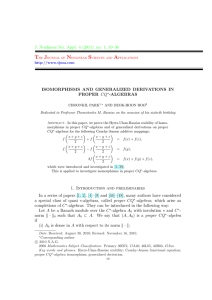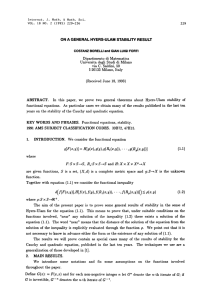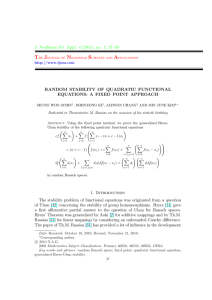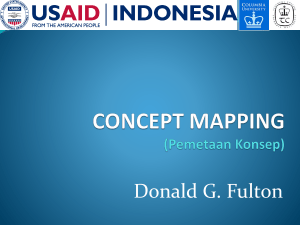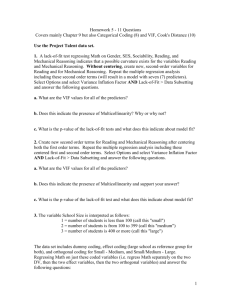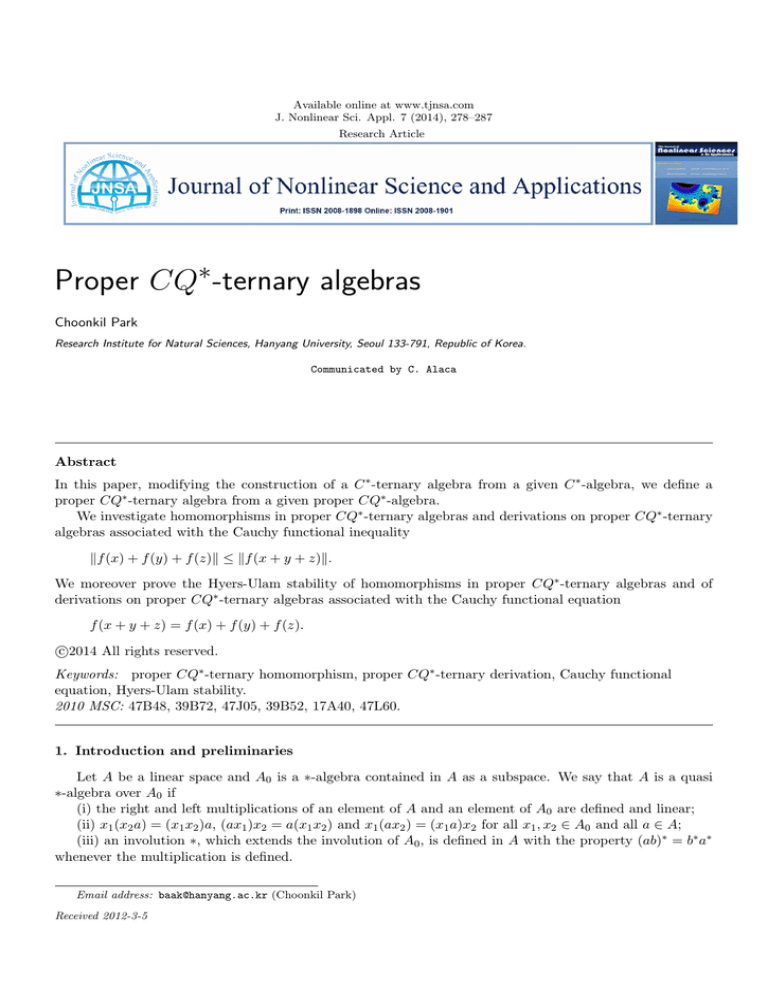
Available online at www.tjnsa.com
J. Nonlinear Sci. Appl. 7 (2014), 278–287
Research Article
Proper CQ∗-ternary algebras
Choonkil Park
Research Institute for Natural Sciences, Hanyang University, Seoul 133-791, Republic of Korea.
Communicated by C. Alaca
Abstract
In this paper, modifying the construction of a C ∗ -ternary algebra from a given C ∗ -algebra, we define a
proper CQ∗ -ternary algebra from a given proper CQ∗ -algebra.
We investigate homomorphisms in proper CQ∗ -ternary algebras and derivations on proper CQ∗ -ternary
algebras associated with the Cauchy functional inequality
kf (x) + f (y) + f (z)k ≤ kf (x + y + z)k.
We moreover prove the Hyers-Ulam stability of homomorphisms in proper CQ∗ -ternary algebras and of
derivations on proper CQ∗ -ternary algebras associated with the Cauchy functional equation
f (x + y + z) = f (x) + f (y) + f (z).
c
2014
All rights reserved.
Keywords: proper CQ∗ -ternary homomorphism, proper CQ∗ -ternary derivation, Cauchy functional
equation, Hyers-Ulam stability.
2010 MSC: 47B48, 39B72, 47J05, 39B52, 17A40, 47L60.
1. Introduction and preliminaries
Let A be a linear space and A0 is a ∗-algebra contained in A as a subspace. We say that A is a quasi
∗-algebra over A0 if
(i) the right and left multiplications of an element of A and an element of A0 are defined and linear;
(ii) x1 (x2 a) = (x1 x2 )a, (ax1 )x2 = a(x1 x2 ) and x1 (ax2 ) = (x1 a)x2 for all x1 , x2 ∈ A0 and all a ∈ A;
(iii) an involution ∗, which extends the involution of A0 , is defined in A with the property (ab)∗ = b∗ a∗
whenever the multiplication is defined.
Email address: baak@hanyang.ac.kr (Choonkil Park)
Received 2012-3-5
C. Park, J. Nonlinear Sci. Appl. 7 (2014), 278–287
279
A quasi ∗-algebra (A, A0 ) is said to be a locally convex quasi ∗-algebra if in A a locally convex topology
τ is defined such that
(i) the involution is continuous and the multiplications are separately continuous;
(ii) A0 is dense in A[τ ].
Throughout this paper, we suppose that a locally convex quasi ∗-algebra (A[τ ], A0 ) is complete. For an
overview on partial ∗-algebra and related topics we refer to [3].
Many authors have considered a special class of quasi ∗-algebras, called proper CQ∗ -algebras, which arise
as completions of C ∗ -algebras. They can be introduced in the following way:
Let A be a Banach module over the C ∗ -algebra A0 with involution ∗ and C ∗ -norm k · k0 such that
A0 ⊂ A. We say that (A, A0 ) is a proper CQ∗ -algebra if
(i) A0 is dense in A with respect to its norm k · k;
(ii) (ab)∗ = b∗ a∗ whenever the multiplication is defined;
(iii) kyk0 = supa∈A,kak≤1 kayk for all y ∈ A0 .
Several mathematician have contributed works on these subjects (see [4]–[10], [43], [44]).
Following the terminology of [2], a non-empty set G with a ternary operation [·, ·, ·] : G × G × G → G is
called a ternary groupoid and is denoted by (G, [·, ·, ·]). The ternary groupoid (G, [·, ·, ·]) is called commutative
if [x1 , x2 , x3 ] = [xσ(1) , xσ(2) , xσ(3) ] for all x1 , x2 , x3 ∈ G and all permutations σ of {1, 2, 3}.
If a binary operation ◦ is defined on G such that [x, y, z] = (x ◦ y) ◦ z for all x, y, z ∈ G, then we say that
[·, ·, ·] is derived from ◦. We say that (G, [·, ·, ·]) is a ternary semigroup if the operation [·, ·, ·] is associative,
i.e., if [[x, y, z], u, v] = [x, [y, z, u], v] = [x, y, [z, u, v]] holds for all x, y, z, u, v ∈ G (see [2]).
A C ∗ -ternary algebra is a complex Banach space A, equipped with a ternary product (x, y, z) 7→ [x, y, z] of
A3 into A, which is C-linear in the outer variables, conjugate C-linear in the middle variable, and associative
in the sense that [x, y, [z, w, v]] = [x, [w, z, y], v] = [[x, y, z], w, v], and satisfies k[x, y, z]k ≤ kxk · kyk · kzk and
k[x, x, x]k = kxk3 (see [2, 48]).
If a C ∗ -ternary algebra (A, [·, ·, ·]) has an identity, i.e., an element e ∈ A such that x = [x, e, e] = [e, e, x]
for all x ∈ A, then it is routine to verify that A, endowed with x ◦ y := [x, e, y] and x∗ := [e, x, e], is a unital
C ∗ -algebra. Conversely, if (A, ◦) is a unital C ∗ -algebra, then [x, y, z] := x ◦ y ∗ ◦ z makes A into a C ∗ -ternary
algebra.
A C-linear mapping H : A → B is called a C ∗ -ternary homomorphism if
H([x, y, z]) = [H(x), H(y), H(z)]
for all x, y, z ∈ A. A C-linear mapping δ : A → A is called a C ∗ -ternary derivation if
δ([x, y, z]) = [δ(x), y, z] + [x, δ(y), z] + [x, y, δ(z)]
for all x, y, z ∈ A (see [2]).
We define a proper CQ∗ -ternary algebra and investigate the properties of proper CQ∗ -ternary algebras.
Definition 1.1. A proper CQ∗ -algebra (A, A0 ), endowed with the triple product
[·, ·, ·] : A0 × A × A0 → A,
which is C-linear in the outer variables, conjugate C-linear in the middle variable and satisfies that [w0 , w, w1 ] ∈
A0 for all w0 , w, w1 ∈ A0 , is called a proper CQ∗ -ternary algebra, and denoted by (A, A0 , [·, ·, ·]).
Example 1.2. (1) Let (A, A0 ) be a proper CQ∗ -algebra. Let
[z, x, w] := zx∗ w
for all x ∈ A and all z, w ∈ A0 . Then (A, A0 , [·, ·, ·]) is a proper CQ∗ -ternary algebra.
(2) A proper JCQ∗ -triple (A, A0 , {·, ·, ·}) is a proper CQ∗ -algebra (A, A0 ), endowed with the Jordan triple
product
1
{z, x, w} := (zx∗ w + wx∗ z)
2
C. Park, J. Nonlinear Sci. Appl. 7 (2014), 278–287
280
for all x ∈ A and all z, w ∈ A0 (see [29]). It is obvious that every proper JCQ∗ -triple is a proper CQ∗ -ternary
algebra if we let [·, ·, ·] := {·, ·, ·}.
Definition 1.3. Let (A, A0 , [·, ·, ·]) and (B, B0 , [·, ·, ·]) be proper CQ∗ -ternary algebras.
(i) A C-linear mapping H : A → B is called a proper CQ∗ -ternary homomorphism if H(z), H(w) ∈ B0
and
H([z, x, w]) = [H(z), H(x), H(w)]
for all z, w ∈ A0 and all x ∈ A.
(ii) A C-linear mapping δ : A0 → A is called a proper CQ∗ -ternary derivation if
δ([w0 , w1 , w2 ]) = [w2 , δ(w0 )∗ , w1∗ ] + [w0 , δ(w1 ), w2 ] + [w1∗ , δ(w2 )∗ , w0 ]
for all w0 , w1 , w2 ∈ A0 .
The stability problem of functional equations originated from a question of Ulam [45] concerning the
stability of group homomorphisms. Hyers [18] gave a first affirmative answer to the question of Ulam for
Banach spaces. Th.M. Rassias [33] provided a generalization of Hyers’ Theorem which allows the Cauchy
difference to be unbounded.
Theorem 1.4. [33] Let f : E → E 0 be a mapping from a normed vector space E into a Banach space E 0
subject to the inequality
kf (x + y) − f (x) − f (y)k ≤ ε(kxkp + kykp )
(1)
for all x, y ∈ E, where ε and p are constants with ε > 0 and p < 1. Then the limit
f (2n x)
n→∞
2n
L(x) = lim
exists for all x ∈ E and L : E → E 0 is the unique additive mapping which satisfies
kf (x) − L(x)k ≤
2ε
kxkp
2 − 2p
for all x ∈ E. Also, if for each x ∈ E the mapping f (tx) is continuous in t ∈ R, then L is linear.
Th.M. Rassias [34] during the 27th International Symposium on Functional Equations asked the question
whether such a theorem can also be proved for p ≥ 1. Gajda [16] following the same approach as in Th.M.
Rassias [33], gave an affirmative solution to this question for p > 1. It was shown by Gajda [16], as well
as by Th.M. Rassias and Šemrl [38] that one cannot prove a Th.M. Rassias’ type theorem when p = 1.
The counterexamples of Gajda [16], as well as of Th.M. Rassias and Šemrl [38] have stimulated several
mathematicians to invent new definitions of approximately additive or approximately linear mappings, cf.
Găvruta [17], Jung [22], who among others studied the Hyers-Ulam stability of functional equations. The
inequality (1) that was introduced for the first time by Th.M. Rassias [33] provided a lot of influence in
the development of a generalization of the Hyers-Ulam stability concept (cf. the books of Czerwik [13, 14],
Hyers, Isac and Th.M. Rassias [19]).
J.M. Rassias [30] following the spirit of the innovative approach of Th.M. Rassias [33] for the unbounded
Cauchy difference proved a similar stability theorem in which he replaced the factor kxkp +kykp by kxkp ·kykq
for p, q ∈ R with p + q 6= 1 (see also [31] for a number of other new results).
Găvruta [17] provided a further generalization of Th.M. Rassias’ Theorem. Isac and Th.M. Rassias [21]
applied the Hyers-Ulam stability theory to prove fixed point theorems and study some new applications in
Nonlinear Analysis. In [20], Hyers, Isac and Th.M. Rassias studied the asymptoticity aspect of Hyers-Ulam
stability of mappings. Beginning around the year 1980, the topic of approximate homomorphisms and their
stability theory in the field of functional equations and inequalities was taken up by several mathematicians
(see [1, 11, 12, 15], [24]–[28], [32], [35]–[42], [46, 47]).
C. Park, J. Nonlinear Sci. Appl. 7 (2014), 278–287
281
This paper is organized as follows: In Sections 2 and 3, we investigate homomorphisms and derivations
in proper CQ∗ -ternary algebras associated with the Cauchy functional inequality
kf (x) + f (y) + f (z)k ≤ kf (x + y + z)k.
In Sections 4 and 5, we prove the Hyers-Ulam stability of homomorphisms in proper CQ∗ -ternary algebras
and of derivations on proper CQ∗ -ternary algebras associated with the Cauchy functional equation
f (x + y + z) = f (x) + f (y) + f (z).
Throughout this paper, assume that (A, A0 , [·, ·, ·]) is a proper CQ∗ -ternary algebra with C ∗ -norm k · kA0
and norm k · kA , and that (B, B0 , [·, ·, ·]) is a proper CQ∗ -ternary algebra with C ∗ -norm k · kB0 and norm
k · kB .
2. Homomorphisms in proper CQ∗ -ternary algebras
In this section, we investigate homomorphisms in proper CQ∗ -ternary algebras.
Theorem 2.1. Let r 6= 1 and θ be nonnegative real numbers, and f : A → B a mapping satisfying f (w) ∈ B0
for all w ∈ A0 such that
kµf (x) + f (y) + f (z)kB ≤ kf (µx + y + z)kB ,
kf ([w0 , x, w1 ]) − [f (w0 ), f (x), f (w1 )]kB ≤
θ(kw0 k3r
A
+
kxk3r
A
+
(2)
kw1 k3r
A)
(3)
for all µ ∈ T:= {λ ∈C | |λ| = 1}, all w0 , w1 ∈ A0 and all x, y, z ∈ A. Then the mapping f : A → B is a
proper CQ∗ -ternary homomorphism.
Proof. Let µ = 1 in (2). By [29, Proposition 2.1], the mapping f : A → B is Cauchy additive.
Letting z = 0 and y = −µx in (2), we get
µf (x) − f (µx) = µf (x) + f (−µx) = 0
for all µ ∈ T and all x ∈ A. So f (µx) = µf (x) for all µ ∈ T and all x ∈ A. By the same reasoning as in the
proof of [23, Theorem 2.1], the mapping f : A → B is C-linear.
(i) Assume that r < 1. By (3),
kf ([w0 , x, w1 ]) − [f (w0 ), f (x), f (w1 )]kB
1
= lim n kf (8n [w0 , x, w1 ]) − [f (2n w0 ), f (2n x), f (2n w1 )]kB
n→∞ 8
8nr
3r
3r
≤ lim n θ(kw0 k3r
A + kxkA + kw1 kA ) = 0
n→∞ 8
for all w0 , w1 ∈ A0 and all x ∈ A. So
f ([w0 , x, w1 ]) = [f (w0 ), f (x), f (w1 )]
for all w0 , w1 ∈ A0 and all x ∈ A.
(ii) Assume that r > 1. By a similar method to the proof of the case (i), one can prove that the mapping
f : A → B satisfies
f ([w0 , x, w1 ]) = [f (w0 ), f (x), f (w1 )]
for all w0 , w1 ∈ A0 and all x ∈ A.
Since f (w) ∈ B0 for all w ∈ A0 , the mapping f : A → B is a proper CQ∗ -ternary homomorphism, as
desired.
C. Park, J. Nonlinear Sci. Appl. 7 (2014), 278–287
282
Theorem 2.2. Let r 6= 1 and θ be nonnegative real numbers, and f : A → B a mapping satisfying (2) and
f (w) ∈ B0 for all w ∈ A0 such that
kf ([w0 , x, w1 ]) − [f (w0 ), f (x), f (w1 )]kB ≤ θ · kw0 krA · kxkrA · kw1 krA
(4)
for all w0 , w1 ∈ A0 and all x ∈ A. Then the mapping f : A → B is a proper CQ∗ -ternary homomorphism.
Proof. By the same reasoning as in the proof of Theorem 2.1, the mapping f : A → B is C-linear.
(i) Assume that r < 1. By (4),
kf ([w0 , x, w1 ]) − [f (w0 ), f (x), f (w1 )]kB
1
= lim n kf (8n [w0 , x, w1 ]) − [f (2n w0 ), f (2n x), f (2n w1 )]kB
n→∞ 8
8nr
≤ lim n θ · kw0 krA · kxkrA · kw1 krA = 0
n→∞ 8
for all w0 , w1 ∈ A0 and all x ∈ A. So
f ([w0 , x, w1 ]) = [f (w0 ), f (x), f (w1 )]
for all w0 , w1 ∈ A0 and all x ∈ A.
(ii) Assume that r > 1. By a similar method to the proof of the case (i), one can prove that the mapping
f : A → B satisfies
f ([w0 , x, w1 ]) = [f (w0 ), f (x), f (w1 )]
for all w0 , w1 ∈ A0 and all x ∈ A.
Therefore, the mapping f : A → B is a proper CQ∗ -ternary homomorphism.
3. Derivations on proper CQ∗ -ternary algebras
In this section, we investigate derivations on proper CQ∗ -ternary algebras.
Theorem 3.1. Let r 6= 1 and θ be nonnegative real numbers, and f : A0 → A a mapping such that
kµf (x) + f (y) + f (z)kA ≤ kf (µx + y + z)kA ,
∗
kf ([w0 , w1 , w2 ]) − [w2 , f (w0 )
, w1∗ ]
−[w1∗ , f (w2 )∗ , w0 ]kA
(5)
− [w0 , f (w1 ), w2 ]
≤
θ(kw0 k3r
A
+
kw1 k3r
A
(6)
+
kw2 k3r
A)
for all µ ∈ T and all w0 , w1 , w2 , x, y, z ∈ A0 . Then the mapping f : A0 → A is a proper CQ∗ -ternary
derivation.
Proof. By the same reasoning as in the proof of Theorem 2.1, the mapping f : A0 → A is C-linear.
(i) Assume that r < 1. By (6),
kf ([w0 , w1 , w2 ]) − [w2 , f (w0 )∗ , w1∗ ] − [w0 , f (w1 ), w2 ] − [w1∗ , f (w2 )∗ , w0 ]kA
1
= lim n kf (8n [w0 , w1 , w2 ]) − [2n w2 , f (2n w0 )∗ , 2n w1∗ ]
n→∞ 8
− [2n w0 , f (2n w1 ), 2n w2 ] − [2n w1∗ , f (2n w2 )∗ , 2n w0 ]kA
8nr
3r
3r
≤ lim n θ(kw0 k3r
A + kw1 kA + kw2 kA ) = 0
n→∞ 8
for all w0 , w1 , w2 ∈ A0 . So
f ([w0 , w1 , w2 ]) = [w2 , f (w0 )∗ , w1∗ ] + [w0 , f (w1 ), w2 ] + [w1∗ , f (w2 )∗ , w0 ]
C. Park, J. Nonlinear Sci. Appl. 7 (2014), 278–287
283
for all w0 , w1 , w2 ∈ A0 .
(ii) Assume that r > 1. By a similar method to the proof of the case (i), one can prove that the mapping
f : A0 → A satisfies
f ([w0 , w1 , w2 ]) = [w2 , f (w0 )∗ , w1∗ ] + [w0 , f (w1 ), w2 ] + [w1∗ , f (w2 )∗ , w0 ]
for all w0 , w1 , w2 ∈ A0 .
Therefore, the mapping f : A0 → A is a proper CQ∗ -ternary derivation.
Theorem 3.2. Let r 6= 1 and θ be nonnegative real numbers, and f : A0 → A a mapping satisfying (5) such
that
kf ([w0 , w1 , w2 ]) − [w2 , f (w0 )∗ , w1∗ ] − [w0 , f (w1 ), w2 ]
−
[w1∗ , f (w2 )∗ , w0 ]kA
≤θ·
kw0 krA
·
kw1 krA
(7)
·
kw2 krA
for all w0 , w1 , w2 ∈ A0 . Then the mapping f : A0 → A is a proper CQ∗ -ternary derivation.
Proof. The proof is similar to the proofs of Theorems 2.2 and 3.1.
4. Stability of homomorphisms in proper CQ∗ -ternary algebras
We prove the Hyers-Ulam stability of homomorphisms in proper CQ∗ -ternary algebras.
Theorem 4.1. Let r > 1 and θ be nonnegative real numbers, and let f : A → B be a mapping satisfying
(3) such that f (w) ∈ B0 for all w ∈ A0 and
kf (µx + µy + µz) − µf (x) − µf (y) − µf (z)kB
≤
θ(kxkrA
+
kykrA
+
(8)
kzkrA ),
kf (w0 + w1 + w2 ) − f (w0 ) − f (w1 ) − f (w2 )kB0
≤
θ(kw0 krA0
+
kw1 krA0
+
(9)
kw2 krA0 )
for all µ ∈ T, all w0 , w1 , w2 ∈ A0 and all x, y, z ∈ A. Then there exists a unique proper CQ∗ -ternary
homomorphism H : A → B such that
kf (x) − H(x)kB ≤
3θ
kxkrA
−3
(10)
3r
for all x ∈ A.
Proof. Let us assume µ = 1 and x = y = z in (8). Then we get
kf (3x) − 3f (x)kB ≤ 3θkxkrA
for all x ∈ A. So
(11)
x
3θ
kf (x) − 3f ( )kB ≤ r kxkrA
3
3
for all x ∈ A. Hence
k3l f (
m−1
m−1
X
x
x
x
x
3θ X 3j
m
j
j+1
)
−
3
f
(
)k
≤
k3
f
(
)
−
3
f
(
)k
≤
kxkrA
B
B
3m
3j
3j+1
3r
3rj
3l
j=l
(12)
j=l
for all nonnegative integers m and l with m > l and all x ∈ A. From this it follows that the sequence
{3n f ( 3xn )} is Cauchy for all x ∈ A. Since B is complete, the sequence {3n f ( 3xn )} converges. Thus one can
define the mapping H : A → B by
x
H(x) := lim 3n f ( n )
n→∞
3
C. Park, J. Nonlinear Sci. Appl. 7 (2014), 278–287
284
for all x ∈ A. Moreover, letting l = 0 and passing the limit m → ∞ in (12), we get (10).
It follows from (8) that
kH(µx + µy + µz) − µH(x) − µH(y) − µH(z)kB
µx + µy + µz
x
y
z
= lim 3n kf (
) − µf ( n ) − µf ( n ) − µf ( n )kB
n
n→∞
3
3
3
3
3n θ
≤ lim nr (kxkrA + kykrA + kzkrA ) = 0
n→∞ 3
for all µ ∈ T and all x, y, z ∈ A. So
H(µx + µy + µz) = µH(x) + µH(y) + µH(z)
for all µ ∈ T and all x, y, z ∈ A. By the same reasoning as in the proof of [23, Theorem 2.1], the mapping
H : A → B is C-linear.
Now, let T : A → B be another additive mapping satisfying (10). Then we have
x
x
kH(x) − T (x)kB = 3n kH( n ) − T ( n )kB
3
3
x
x
x
x
≤ 3n (kH( n ) − f ( n )kB + kT ( n ) − f ( n )kB )
3
3
3
3
6 · 3n θ
kxkrA ,
≤
3nr (3r − 3)
which tends to zero as n → ∞ for all x ∈ A. So we can conclude that H(x) = T (x) for all x ∈ A. This
proves the uniqueness of H.
It follows from (9) that H(w) = limn→∞ 3n f ( 3wn ) ∈ B0 for all w ∈ A0 . So it follows from (3) that
kH([w0 , x, w1 ]) − [H(w0 ), H(x), H(w1 )]kB
[w0 , x, w1 ]
w0
x
w1
= lim 33n kf (
) − [f ( n ), f ( n ), f ( n )]kB
3n
n→∞
3
3
3
3
33n
3r
3r
≤ lim 3nr θ(kw0 k3r
A + kxkA + kw1 kA ) = 0
n→∞ 3
for all w0 , w1 ∈ A0 and all x ∈ A. So
H([w0 , x, w1 ]) = [H(w0 ), H(x), H(w1 )]
for all w0 , w1 ∈ A0 and all x ∈ A.
Thus the mapping H : A → B is a unique proper CQ∗ -ternary homomorphism satisfying (10), as desired.
Theorem 4.2. Let r < 1 and θ be nonnegative real numbers, and let f : A → B be a mapping satisfying
(3), (8) and (9) such that f (w) ∈ B0 for all w ∈ A0 . Then there exists a unique proper CQ∗ -ternary
homomorphism H : A → B such that
kf (x) − H(x)kB ≤
3θ
kxkrA
3 − 3r
(13)
for all x ∈ A.
Proof. It follows from (11) that
1
kf (x) − f (3x)kB ≤ θkxkrA
3
for all x ∈ A. So
k
m−1
m−1
X 1
X 3jr
1
1
1
l
m
j
j+1
f
(3
x)
−
f
(3
x)k
≤
k
f
(3
x)
−
f
(3
x)k
≤
θkxkrA
B
B
3m
3j
3j+1
3j
3l
j=l
j=l
(14)
C. Park, J. Nonlinear Sci. Appl. 7 (2014), 278–287
285
for all nonnegative integers m and l with m > l and all x ∈ A. From this it follows that the sequence
{ 31n f (3n x)} is Cauchy for all x ∈ A. Since B is complete, the sequence { 31n f (3n x)} converges. So one can
define the mapping H : A → B by
1
H(x) := lim n f (3n x)
n→∞ 3
for all x ∈ A. Moreover, letting l = 0 and passing the limit m → ∞ in (14), we get (13).
The rest of the proof is similar to the proof of Theorem 4.1.
5. Stability of derivations on proper CQ∗ -ternary algebras
We prove the Hyers-Ulam stability of derivations on proper CQ∗ -ternary algebras.
Theorem 5.1. Let r > 1 and θ be nonnegative real numbers, and let f : A0 → A be a mapping satisfying
(6) such that
kf (µw0 + µw1 + µw2 ) − µf (w0 ) − µf (w1 ) − µf (w2 )kA
≤
θ(kw0 krA
+
kw1 krA
+
(15)
kw2 krA )
for all µ ∈ T and all w0 , w1 , w2 ∈ A0 . Then there exists a unique proper CQ∗ -ternary derivation δ : A0 → A
such that
kf (w) − δ(w)kA ≤
3θ
kwkrA
−3
(16)
3r
for all w ∈ A0 .
Proof. By the same reasoning as in the proof of Theorem 4.1, there exists a unique C-linear mapping
δ : A0 → A satisfying (16). The mapping δ : A0 → A is given by
δ(w) := lim 3n f (
n→∞
w
)
3n
for all w ∈ A0 .
It follows from (6) that
kδ([w0 , w1 , w2 ]) − [w2 , δ(w0 )∗ , w1∗ ] − [w0 , δ(w1 ), w2 ] − [w1∗ , δ(w2 )∗ , w0 ]kA
3n w2 n w0 ∗ 3n w1∗
3n w0 n w1 3n w2
[w0 , w1 , w2 ]
= lim k33n f (
)
−
[
,
3
f
(
)
,
]
−
[
, 3 f ( n ), n ]
n→∞
33n
3n
3n
3n
3n
3
3
n
∗
n
3n
3 w
w2
3 w0
3
3r
3r
−[ n 1 , 3n f ( n )∗ , n ]kA ≤ lim 3nr θ(kw0 k3r
A + kw1 kA + kw2 kA ) = 0
n→∞ 3
3
3
3
for all w0 , w1 , w2 ∈ A0 . So
δ([w0 , w1 , w2 ]) = [w2 , δ(w0 )∗ , w1∗ ] + [w0 , δ(w1 ), w2 ] + [w1∗ , δ(w2 )∗ , w0 ]
for all w0 , w1 , w2 ∈ A0 .
Thus the mapping δ : A0 → A is a unique proper CQ∗ -ternary derivation satisfying (16), as desired.
Theorem 5.2. Let r < 1 and θ be nonnegative real numbers, and let f : A0 → A be a mapping satisfying
(6) and (15). Then there exists a unique proper CQ∗ -ternary derivation δ : A0 → A such that
kf (w) − δ(w)kA ≤
3θ
kwkrA
3 − 3r
for all w ∈ A0 .
Proof. The proof is similar to the proofs of Theorems 4.2 and 5.1.
C. Park, J. Nonlinear Sci. Appl. 7 (2014), 278–287
286
Acknowledgements
This work was supported by Basic Science Research Program through the National Research Foundation
of Korea funded by the Ministry of Education, Science and Technology (NRF-2012R1A1A2004299).
References
[1] M. Adam, On the stability of some quadratic functional equation, J. Nonlinear Sci. Appl., 4 (2011), 50–59. 1
[2] M. Amyari and M. S. Moslehian, Approximately ternary semigroup homomorphisms, Lett. Math. Phys., 77
(2006), 1–9. 1
[3] J. P. Antoine, A. Inoue and C. Trapani, Partial ∗-Algebras and Their Operator Realizations, Kluwer, Dordrecht,
(2002). 1
[4] F. Bagarello, Applications of topological ∗-algebras of unbounded operators, J. Math. Phys., 39 (1998), 6091–6105.
1
[5] F. Bagarello, Fixed point results in topological ∗-algebras of unbounded operators, Publ. RIMS Kyoto Univ., 37
(2001), 397–418.
[6] F. Bagarello, Applications of topological ∗-algebras of unbounded operators to modified quons, Nuovo Cimento B,
117 (2002), 593–611.
[7] F. Bagarello and C. Trapani, A note on the algebraic approach to the “almost” mean field Heisenberg model,
Nuovo Cimento B, 108 (1993), 779–784.
[8] F. Bagarello and C. Trapani, States and representations of CQ∗ -algebras, Ann. Inst. H. Poincaré, 61 (1994),
103–133.
[9] F. Bagarello and C. Trapani, The Heisenberg dynamics of spin systems: a quasi-∗-algebras approach, J. Math.
Phys., 37 (1996), 4219–4234.
[10] F. Bagarello, C. Trapani and S. Triolo, Quasi ∗-algebras of measurable operators, Studia Math., 172 (2006),
289–305. 1
[11] L. Cădariu, L. Găvruta and P. Găvruta, On the stability of an affine functional equation, J. Nonlinear Sci. Appl.,
6 (2013), 60–67. 1
[12] A. Chahbi and N. Bounader, On the generalized stability of d’Alembert functional equation, J. Nonlinear Sci.
Appl., 6 (2013), 198–204. 1
[13] S. Czerwik, Functional Equations and Inequalities in Several Variables, World Scientific Publishing Company,
New Jersey, London, Singapore and Hong Kong, (2002). 1
[14] S. Czerwik, Stability of Functional Equations of Ulam-Hyers-Rassias Type, Hadronic Press, Palm Harbor, Florida,
(2003). 1
[15] G. Z. Eskandani and P. Gǎruta, Hyers-Ulam-Rassias stability of pexiderized Cauchy functional equation in 2Banach spaces, J. Nonlinear Sci. Appl., 5 (2012), 459–465. 1
[16] Z. Gajda, On stability of additive mappings, Internat. J. Math. Math. Sci., 14 (1991), 431–434. 1
[17] P. Gǎvruta, A generalization of the Hyers-Ulam-Rassias stability of approximately additive mappings, J. Math.
Anal. Appl., 184 (1994), 431–436. 1
[18] D. H. Hyers, On the stability of the linear functional equation, Proc. Nat. Acad. Sci. U.S.A., 27 (1941), 222–224.
1
[19] D. H. Hyers, G. Isac and Th. M. Rassias, Stability of Functional Equations in Several Variables, Birkhäuser,
Basel, (1998). 1
[20] D. H. Hyers, G. Isac and Th. M. Rassias, On the asymptoticity aspect of Hyers-Ulam stability of mappings, Proc.
Amer. Math. Soc., 126 (1998), 425–430. 1
[21] G. Isac and Th. M. Rassias, Stability of ψ-additive mappings : Applications to nonlinear analysis, Internat. J.
Math. Math. Sci., 19 (1996), 219–228. 1
[22] S. Jung, On the Hyers-Ulam-Rassias stability of approximately additive mappings, J. Math. Anal. Appl., 204
(1996), 221–226. 1
[23] C. Park, Homomorphisms between Poisson JC ∗ -algebras, Bull. Braz. Math. Soc., 36 (2005), 79–97. 1, 5
[24] C. Park, Approximate homomorphisms on JB ∗ -triples, J. Math. Anal. Appl., 306 (2005), 375–381. 1
[25] C. Park, Isomorphisms between C ∗ -ternary algebras, J. Math. Phys., 47, no. 10, 103512 (2006).
[26] C. Park, Orthogonal stability of a cubic-quartic functional equation, J. Nonlinear Sci. Appl., 5 (2012), 28–36.
[27] C. Park, M. Eshaghi Gordji and A. Najati, Generalized Hyers-Ulam stability of an AQCQ-functional equation in
non-Archimedean Banach spaces, J. Nonlinear Sci. Appl., 3 (2010), 272–281.
[28] C. Park and Th. M. Rassias, Homomorphisms in C ∗ -ternary algebras and JB ∗ -triples, J. Math. Anal. Appl.,
337 (2008), 13–20. 1
[29] C. Park and Th. M. Rassias, Homomorphisms and derivations in proper JCQ∗ -triples, J. Math. Anal. Appl.,
337 (2008), 1404–1414. 1.2, 1
[30] J. M. Rassias, On approximation of approximately linear mappings by linear mappings, Bull. Sci. Math., 108
(1984), 445–446. 1
C. Park, J. Nonlinear Sci. Appl. 7 (2014), 278–287
287
[31] J. M. Rassias, Solution of a problem of Ulam, J. Approx. Theory, 57 (1989), 268–273. 1
[32] M. J. Rassias, J. M. Rassias product-sum stability of an Euler-Lagrange functional equation, J. Nonlinear Sci.
Appl., 3 (2010), 265–271. 1
[33] Th. M. Rassias, On the stability of the linear mapping in Banach spaces, Proc. Amer. Math. Soc., 72 (1978),
297–300. 1, 1.4, 1
[34] Th. M. Rassias, Problem 16; 2, Report of the 27th International Symp. on Functional Equations, Aequationes
Math., 39 (1990), 292–293. 1
[35] Th. M. Rassias, The problem of S.M. Ulam for approximately multiplicative mappings, J. Math. Anal. Appl.,
246 (2000), 352–378. 1
[36] Th. M. Rassias, On the stability of functional equations in Banach spaces, J. Math. Anal. Appl., 251 (2000),
264–284.
[37] Th. M. Rassias, Functional Equations, Inequalities and Applications, Kluwer Academic Publishers, Dordrecht,
Boston and London, (2003).
[38] Th.M. Rassias and P. Šemrl, On the behaviour of mappings which do not satisfy Hyers-Ulam stability, Proc.
Amer. Math. Soc., 114 (1992), 989–993. 1
[39] Th. M. Rassias and P. Šemrl, On the Hyers-Ulam stability of linear mappings, J. Math. Anal. Appl., 173 (1993),
325–338.
[40] K. Ravi, E. Thandapani and B. V. Senthil Kumar, Solution and stability of a reciprocal type functional equation
in several variables, J. Nonlinear Sci. Appl., 7 (2014), 18–27.
[41] S. Schin, D. Ki, J. Chang and M. Kim, Random stability of quadratic functional equations: a fixed point approach,
J. Nonlinear Sci. Appl., 4 (2011), 37–49.
[42] F. Skof, Proprietà locali e approssimazione di operatori, Rend. Sem. Mat. Fis. Milano, 53 (1983), 113–129. 1
[43] C. Trapani, Some seminorms on quasi-∗-algebras, Studia Math., 158 (2003), 99–115. 1
[44] C. Trapani, Bounded elements and spectrum in Banach quasi ∗-algebras, Studia Math., 172 (2006), 249–273. 1
[45] S. M. Ulam, A Collection of the Mathematical Problems, Interscience Publ. New York, 1960. 1
[46] C. Zaharia, On the probabilistic stability of the monomial functional equation, J. Nonlinear Sci. Appl., 6 (2013),
51–59. 1
[47] S. Zolfaghari, Approximation of mixed type functional equations in p-Banach spaces, J. Nonlinear Sci. Appl., 3
(2010), 110–122. 1
[48] H. Zettl, A characterization of ternary rings of operators, Adv. Math., 48 (1983), 117–143. 1

